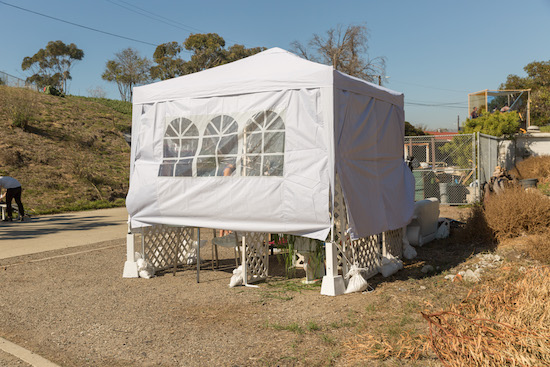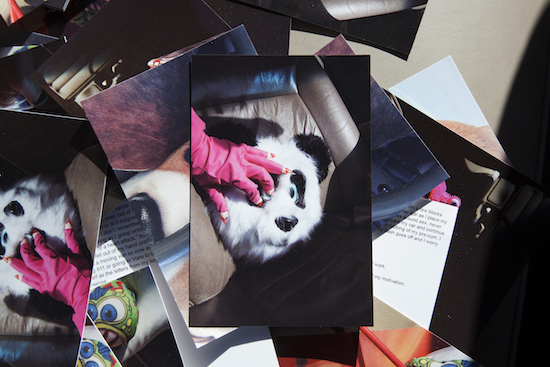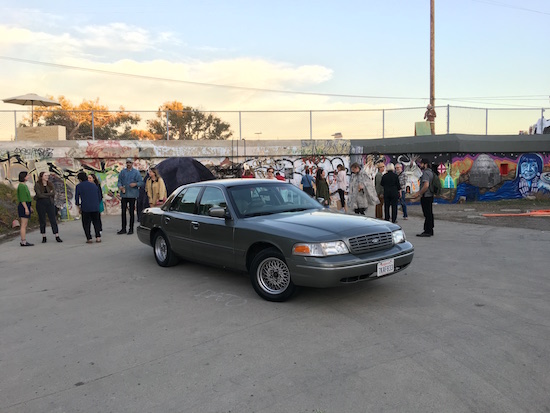gallery1993 at Other Places art fair
“I had this vision of seven ladies listening to rap music and building a house and we did it,” Katie Bode says to me, describing Abode Gallery’s booth at the first iteration of Other Places art fair (OPaf) 2018 as she guides me to her couch next to the house-shaped tent (with windows).
Abode Gallery is known for its unique way of approaching exhibition spaces and experiences, with the opening and closings functioning as dinners, hosting a more welcoming and intimate atmosphere to view the art exhibited. When Bode was approached by Keith Rocka Knittel, the artist who organized OPaf, the independent curator and founder of Abode Gallery realized she needed to figure out how to translate a “specific living-room project” into an art fair context.
This contextualization, however, bears no resemblance to that of a standard fair. Each of the 24 participants at OPaf presented site-specific booths at Angels Gate Park in San Pedro, en plein air while overlooking the ocean. The fair exclusively consists of Los Angeles artist-run and alternative spaces. While many of these spaces are not necessarily non-commercial, such as Abode, the fair’s title “Other Places” reflects an ethos of showcasing art in precisely other places outside of such commercial settings typical in the art world, reminding us that art can be involved in daily experiences and natural contexts.
Back on the couch, cozily warmed by the sun, Bode describes to me in detail the purpose of the house. She realized the best way to incorporate her house gallery into OPaf was to create a similar space at the fair. Bode asked artists to create furniture, ranging from a toilet by Andrea Marie Breiling and bed by Tanya Brodsky to a table covered with a photo transfer of Abode’s carpet by Brodsky and Ellen Schafer. Treating the install of the “furniture” – or domesticated art objects – as a collective effort, Abode’s contribution to OPaf reflects exactly what the fair stands for: shared values of community and art in nontraditional art spaces.
“It’s so fun. I’ve worked for art fairs before and at the root it’s about a tribal thing of getting everyone together and pulling our resources. That … really nailed what we’re all trying to do, which is creating our own visions for making and showing art.”
The idea of nourishing oneself while allowing for a slower, more meditative viewing of art, in conversation with others at the dinner table may not be entirely unprecedented. And yet, in a city continuously populating with new art galleries, Abode offers a radically welcoming alternative.
“My curatorial spot is nontraditional spaces so I’ve done a lot of shows in other peoples’ houses and bathrooms and backyards. For the house gallery, it’s about changing the way you interact with the art. When you go into a white box space, it’s so forceful. You’re here, you have to look at this thing, there’s a main arena. It all has to happen instantaneously. A lot of art does better with a slow burn. So: you sit, you have dinner, you have a glass of wine, and the art has been marinating in the back of your head the whole time. It’s a different way to interact with it and you’re doing it in a house – I’m not trying to be a proper gallery.”

Abode Gallery’s booth at Other Places Art Fair.
Equally innovative is gallery1993, another alternative space that had to recontextualize its space for OPaf. Gallery1993, run by Seymour Polatin, is a Ford Crown Victoria car in which the viewer is picked up and taken for a ride while observing and interacting with the exhibition on display. Polatin best describes it as “driving for the sake of driving and viewing contemporary art in motion.”
For OPaf, gallery1993 was parked with its doors open and Polatin inviting viewers to rummage around the art, read it, turn it around, and even sit on it – retaining some of that motion central to the gallery. On view was Paul Pescador’s Ajar consisting of massive piles of postcards, dual sides of photographic and written elements, scattered around the seats of the car. Disturbingly carnal and erotic in the most playful and artificial of ways, the photographs are noticeably taken inside the gallery with the recognizable wrinkled, grey-beige textures of Polatin’s car in the background.
“It explores the transitory nature of showing art in the car,” explained Polatin, in between letting fair-goers know that they could sit on the art if they so pleased, “and it goes through the daily and social interactions that people have that live in a car culture such as Los Angeles. Paul Pescador, the artist, grew up in Palm Springs, which is very much in the desert, in this car culture, and it explores interactions he has on a daily basis – sexual interactions – and how that functions when everybody lives in their own private, public space – like the car.”
While this private-in-a-public space idea of cars carries into universal territory, site-specificity remains a central component of Polatin’s gallery, as indicated by Pescador’s exhibition and the connotations and necessity of cars in Los Angeles. This isn’t to say that gallery1993 is restricted to Los Angeles. But more so that the gallery and art displayed can become something completely different in areas outside of the car-polluted city.

Paul Pescador, Ajar, at gallery1993, Other Places art fair
“I started this project in Boston in the same make and model of the car, Crown Victoria, and space in Boston means a much different thing than it does in Los Angeles. Even cars mean a different thing. Not many people drive in Boston, but space is a lot harder to come by. So, alternative spaces don’t really have as much availability as they do in Los Angeles, but car culture has a larger presence [in Los Angeles] so it shifts based on the conversation of transportation of the city.”
Like Abode, gallery1993 places emphasis on conversations around the art and creating a space that invites this. While the latter space is less figuratively in transit as it is in actuality, both spaces as others at OPaf, generate an image of the thriving Los Angeles alternative art space community as in transit and enchantingly fluid – not so much a journey with a destination as an endless conversation – leading to more conversations, more interactions, and, perhaps even more alternative spaces for art.
Paul Pescador, Ajar, is at gallery1993 until 30 March. Angie Jennings, Extinct Paradise, opens at Abode Gallery in March


